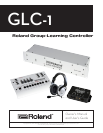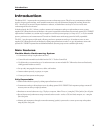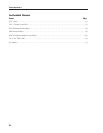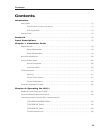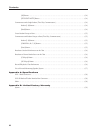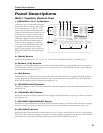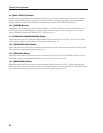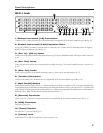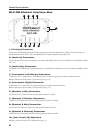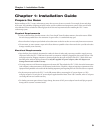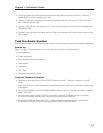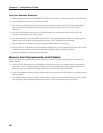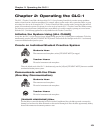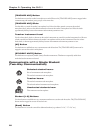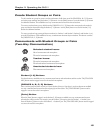
1
Introduction
The Roland GLC-1 represents the next generation in music conferencing systems. This all-in-one communication solution
is perfect for group piano teaching, music ensemble instruction, and even sophisticated language lab teaching. Because the
GLC-1 doesn’t rely on external computer hardware or software, it’s both intuitive and easy-to-use. As a result, music
conferencing will never be the same.
In Standard mode, the GLC-1 allows a teacher to monitor and communicate with up to eight students in stereo via nine
supplied GLC-SB interface boxes and headsets—the system’s expandable to 48 students in stereo with optional GLC-EXPKIT
expansion kits. In addition, any student may be assigned to one of four practice groups (i.e. Group A, B, C, or D) for ensemble
practice, performance, and communication. The result is a flexible music conferencing system that’s fully expandable.
The GLC-1 can also operate in Split mode, allowing a teacher to communicate with up to 16 students in mono via nine
supplied GLC-SB interface boxes and headsets by adding optional headsets as needed—or up to 48 students in mono with
optional GLC-EXPKIT expansion kits and additional headsets. (Practice groups are not available in Split mode.)
Main Features
Flexible Music Conferencing System
• Communicate with up to eight students in stereo.
• Control the rack-mountable audio hub from the GLC-1 Teacher Control Pad.
• Use Split mode to accommodate up to 16 students in mono via nine included GLC-SB interface boxes and headsets by
adding optional headsets as needed.
• Set up easily using supplied connectors, cables, and headsets.
• Instruct students privately, in groups, or in pairs.
• Create up to four separate student groups.
Fully Expandable
• Double student headset capacity by adding optional headsets as needed.
• Communicate with up to 48 students in stereo by adding optional GLC-EXPKIT. Each expansion package contains all
necessary items to add up to eight (8) students.
• Broadcast an external audio source (e.g. CD player, computer, Music Tutor, etc.) using the [CD In] and/or [Aux. In] jacks.
• Record lectures and performances using an external audio recorder—such as a CD, hard disk, computer, etc.—using the
[Rec. Out] jacks.
• Monitor and communicate through an external monitoring (speaker) system such as a stereo power-amp with speakers
using the [Mon. Out] jacks.
Introduction



